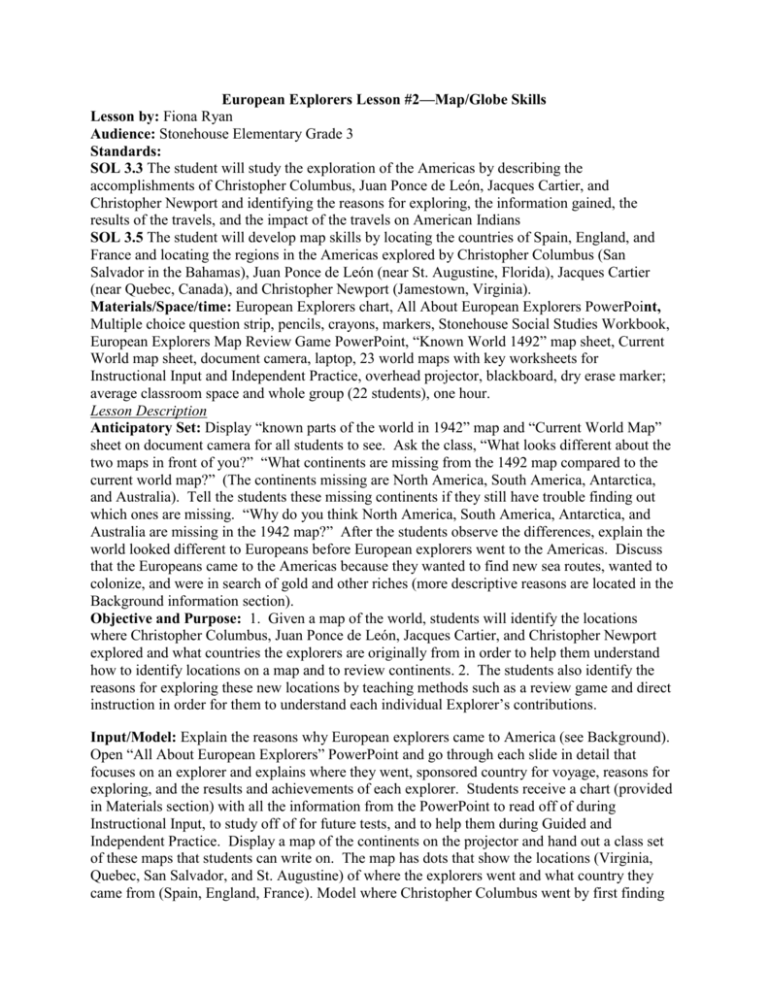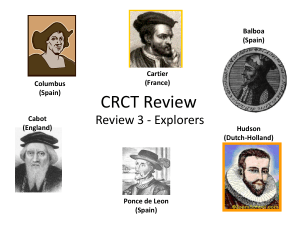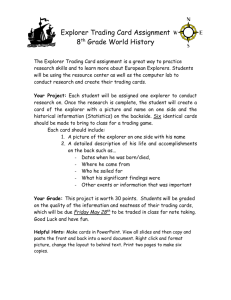Fiona lesson 2
advertisement

European Explorers Lesson #2—Map/Globe Skills Lesson by: Fiona Ryan Audience: Stonehouse Elementary Grade 3 Standards: SOL 3.3 The student will study the exploration of the Americas by describing the accomplishments of Christopher Columbus, Juan Ponce de León, Jacques Cartier, and Christopher Newport and identifying the reasons for exploring, the information gained, the results of the travels, and the impact of the travels on American Indians SOL 3.5 The student will develop map skills by locating the countries of Spain, England, and France and locating the regions in the Americas explored by Christopher Columbus (San Salvador in the Bahamas), Juan Ponce de León (near St. Augustine, Florida), Jacques Cartier (near Quebec, Canada), and Christopher Newport (Jamestown, Virginia). Materials/Space/time: European Explorers chart, All About European Explorers PowerPoint, Multiple choice question strip, pencils, crayons, markers, Stonehouse Social Studies Workbook, European Explorers Map Review Game PowerPoint, “Known World 1492” map sheet, Current World map sheet, document camera, laptop, 23 world maps with key worksheets for Instructional Input and Independent Practice, overhead projector, blackboard, dry erase marker; average classroom space and whole group (22 students), one hour. Lesson Description Anticipatory Set: Display “known parts of the world in 1942” map and “Current World Map” sheet on document camera for all students to see. Ask the class, “What looks different about the two maps in front of you?” “What continents are missing from the 1492 map compared to the current world map?” (The continents missing are North America, South America, Antarctica, and Australia). Tell the students these missing continents if they still have trouble finding out which ones are missing. “Why do you think North America, South America, Antarctica, and Australia are missing in the 1942 map?” After the students observe the differences, explain the world looked different to Europeans before European explorers went to the Americas. Discuss that the Europeans came to the Americas because they wanted to find new sea routes, wanted to colonize, and were in search of gold and other riches (more descriptive reasons are located in the Background information section). Objective and Purpose: 1. Given a map of the world, students will identify the locations where Christopher Columbus, Juan Ponce de León, Jacques Cartier, and Christopher Newport explored and what countries the explorers are originally from in order to help them understand how to identify locations on a map and to review continents. 2. The students also identify the reasons for exploring these new locations by teaching methods such as a review game and direct instruction in order for them to understand each individual Explorer’s contributions. Input/Model: Explain the reasons why European explorers came to America (see Background). Open “All About European Explorers” PowerPoint and go through each slide in detail that focuses on an explorer and explains where they went, sponsored country for voyage, reasons for exploring, and the results and achievements of each explorer. Students receive a chart (provided in Materials section) with all the information from the PowerPoint to read off of during Instructional Input, to study off of for future tests, and to help them during Guided and Independent Practice. Display a map of the continents on the projector and hand out a class set of these maps that students can write on. The map has dots that show the locations (Virginia, Quebec, San Salvador, and St. Augustine) of where the explorers went and what country they came from (Spain, England, France). Model where Christopher Columbus went by first finding the dot for Spain; color half the dot red and explain both Ponce de León and Columbus came from Spain so the other half is colored later. Students know what a map key is because they learned about it from previous grades. Explain to the students Columbus traveled to San Salvador and point to it on the map. Color the dot completely red and explain even though two explorers came from Spain, only Columbus went to San Salvador. Next, connect Spain and San Salvador by making a dashed red line between the two. Check for Understanding: Using the map, say the rest of the explorers and drag finger on the map to show where the explorer came from. Students wait to give thumbs up when they see the finger is on the right location. Once everyone has their thumbs up on where explorer came from the teacher does the same for where the explorer colonized. Teacher waits for all thumbs to be up to show understanding. If a student does not have thumb up, ask why they disagree. Guided Practice: Students break into teams of two to play a PowerPoint quick review game on the explorers. The students are asked a series of questions to help them remember information from the lesson of the day. Students are asked questions such as: Where is Christopher Newport/Christopher Columbus/ Juan Ponce de León/Jacques Cartier from? Where did Christopher Newport/Christopher Columbus/ Juan Ponce de León/Jacques Cartier sail to? What ocean did they all cross? Finally, teacher asks the individual reasons for each explorer on why they went on their journey. Teacher keeps track of the number of questions each team gets right and determines the winner. After the game, students complete the Juan Ponce de León portion of their map as a class. Teacher asks students where he was from and where he went. Once students are correct, they color St. Augustine Florida and the other half of Spain is colored green. Students then draw a solid green line to connect the two dots. Independent Practice: Students complete the rest of the map after completing Juan Ponce de León. Students can use their chart given earlier to help them locate where the explorers came from and where they went. Students color the rest orange for Cartier and blue for Newport. Students use their crayons also to connect the locations together. Cartier is a dashed orange line and Newport is a solid blue line. Students turn in these maps and teacher checks for completion and helps students who confuse locations in the future if needed prior to testing. Closure: Collect the map worksheets. Pass out multiple-choice question strip that the students must complete independently as an exit ticket before they sit on the carpet for reading. Evaluation: Formative: The teacher observes participation during ‘Check for Understanding’, ‘Guided Practice’, and while the students are working on their maps. The teacher should correct and help any student who seems to be confused about instructions. Summative: The teacher evaluates the final answers on the map worksheet given at the end of class. Teacher also evaluates answers given on the multiple-choice question. Content/Background information: Many explorers long ago became famous due to their discovery of the Americas. Many of the explorers who came to North America were called Europeans, or people from Europe. There were many famous explorers who came to North America during between the 1400’s and 1600’s. Four important European Explorers are Christopher Columbus, Juan Ponce de León, Jacques Cartier, and Christopher Newport. These were explorers who greatly impacted the United States and North America (Stonehouse Workbook, 2014). Christopher Columbus was an explorer from Spain. His reason for exploring was to find a western sea route to Asia in order to trade for spices. He was also the first European to discover a sea route to America. He landed in San Salvador (near the Bahamas) and discovered the western hemisphere in 1492 (http://enchantedlearning.com, 2000). Another famous explorer is Juan Ponce de León. Juan Ponce de León was also an explorer from Spain. His reason for exploring was to discover riches and conquer land for Spain (Stonehouse Workbook, 2014). He was the first European to land in Florida and helped Spain claim Florida in 1513 (http://enchantedlearning.com, 2000). They landed near St. Augustine, Florida when they discovered this new land. The third famous European explorer is Jacques Cartier. He was an explorer from France whose reason for exploring was to colonize the New World. He explored the St. Lawrence River Valley and helped give France a place in North America to claim in 1541 (Stonehouse Workbook, 2014). The St. Lawrence River Valley is located near Quebec, Canada. The final explorer was Christopher Newport who was an explorer from England. His reason for exploring was to discover riches, find a western sea route to Asia, and to colonize Virginia. Christopher Newport helped colonize Jamestown by bringing people over on several different voyages. To colonize means to send a group of settlers to a place and establish political control over it. He was also one of the first men to reach the Fall Line on the James River near Richmond. Christopher Newport helped start Jamestown in 1607 (Stonehouse Workbook, 2014). The impact of colonization on Native Americans will be covered in the controversial issues lesson. Students develop map skills by locating the countries of Spain, England, and France and locating the regions in the Americas explored by Christopher, Juan Ponce de León, Jacques Cartier, and Christopher Newport. Students are exposed to the different continents and oceans in the world prior to this lesson. This makes navigating from Europe to North America easier on the students because they are able to grasp the concept. Students are able to identify the explorers all crossed the Atlantic ocean because these are map and globe skills the students are already familiar with. Students become more descriptive in describing continents such as Europe by being able to identify England, Spain, and France in Europe. Students are able to navigate which direction these explorers went by using their cardinal directions they learned earlier in 3rd grade and drawing compass roses on their map. Cardinal directions are North, South, East, and West. They can also use intermediate directions, which are Northeast, Northwest, Southeast, and Southwest. Intermediate directions are directions located between the cardinal directions (Stonehouse Workbook, 2014). Game based learning encourages “diplomatic and organized communication between children” and “improve children’s focus and lengthen their attention spans” (Schuna, 2014). A student’s creativity, work ethic, and self-esteem increase when they are able to work collaboratively with peers in a friendly competitive setting. Games help challenge minds and help relationships amongst peers. This is why incorporating games in daily lessons is important. Resources Christopher Columbus: Explorer - EnchantedLearning.com. (2000, January 1). Retrieved October 13, 2014, from http://www.enchantedlearning.com/explorers/page/c/columbus.shtml Juan Ponce de Leon: Explorer - EnchantedLearning.com. (2000, January 1). Retrieved October 13, 2014, from http://www.enchantedlearning.com/explorers/page/d/deleon.shtml Known World at the Time of Columbus, 1492. (2009, January 1). Retrieved October 13, 2014, from http://etc.usf.edu/maps/pages/1100/1182/1182.htm Large scale maps. (2014, January 1). Retrieved October 13, 2014, from http://cnx.org/contents/32a7059a-1e94-4fb9-973d-48c05dd240c8@1/Large_scale_maps Schuna, C. (2014, February 4). The Advantages of Playing Learning Games with Kids. Retrieved October 13, 2014, from http://www.livestrong.com/article/214084-the-advantages-of learning-games-for-kids/ Stonehouse Elementary 3rd Grade Social Studies Interactive Notes Workbook Assessment What country did Christopher Columbus come from? (2 pts) A. Spain B. United States of America C. France D. Africa Materials (Anticipatory Set Map) Known World at the Time of Columbus, 1492 Map Current World Map (Anticipatory Set) Instructional Input European Explorers Chart (Students will receive this chart to place in their Social Studies Folder for Future studying) European Explorer Sponsor Country Reasons for Exploring Successes/Results Christopher Spain To find a western sea -First European to Columbus route to Asia discover a sea route to the Americas -Discovered the “New World” (landed in San Salvador) Juan Ponce de León Spain To discover riches -First European to and to conquer land land in Florida (near St. Augustine) Jacques Cartier France To colonize the New -Explored the St. World Lawrence River Valley (near Quebec, Canada) -Gave France a North American claim Christopher Newport England -To discover riches -Arrived at present -To find a western sea day Jamestown route to Asia -Made 4 more -To colonize Virginia voyages bringing more people to Jamestown -Was one of the first men to reach the Fall Line of the James River


